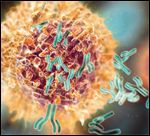ASH: Obinutuzumab Bests Rituximab in Patients With Relapsed Non-Hodgkin Lymphoma
Obinutuzumab (GA101) achieved higher response rates than rituximab in the first head-to-head trial of the two biologic agents in patients with relapsed non-Hodgkin lymphoma.
SAN DIEGO-Obinutuzumab (GA101) achieved higher response rates than rituximab in the first head-to-head trial of the two biologic agents in patients with relapsed non-Hodgkin lymphoma (NHL). Findings of the randomized, international, phase II study were reported by Laurie H. Sehn, MD, MPH, clinical associate professor in the division of medical oncology at the University of British Columbia, Vancouver, BC.

Rituximab binds specifically to CD20, found on developing and mature B cells, but not on stem cells or plasma cells; source: Roche
Obinutuzumab is the first type II bioengineered monoclonal antibody specifically targeting CD20 to be investigated for use in NHL. “The aim of this randomized phase II trial was to compare efficacy and safety of monotherapy with GA101 vs rituximab in patients with relapsed indolent NHL,” said Dr. Sehn.
The primary end point was overall response rate (ORR) in the follicular lymphoma (FL) population. Secondary end points included progression-free survival (PFS), overall survival (OS), and safety outcomes among patients receiving both treatments. Treatment arms were well balanced for standard prognostic features and prior treatment characteristics.
A total of 175 patients (149 FL and 26 non-FL) with indolent NHL were randomized 1:1 to receive 4 weekly infusions (days 1, 8, 15, 22) of either GA101 (1000 mg, n = 87) or rituximab (375 mg/m2, n = 88). End-of-treatment response was assessed 28 to 42 days after the last induction dose. Patients who responded to treatment without evidence of progression following induction therapy received ongoing treatment with GA101 or rituximab at the same dose every 2 months for up to 2 years.
After a complete assessment by the investigators and independent radiology review, the ORR for GA101 was 44.6% vs 33.3% percent for rituximab. The complete remission (or unconfirmed complete remission) rate in the GA101 arm was 12.2% percent compared to 5.3% percent for rituximab.
Overall, said Dr. Sehn, “GA101 was well tolerated by most study participants. Although patients on GA101 treatment had a higher rate of infusion reactions, a common complication of treatment with monoclonal antibodies, they were generally considered mild and did not result in significant differences in treatment discontinuation.”
A greater number of patients in the rituximab arm experienced severe adverse events during the 4-week induction period-11% vs 6% in the obinutuzumab arm. Severe adverse events in GA101 patients included infusion reactions, neutropenia with fever, pleural effusion, and kidney stones. “Finally,” said Dr. Sehn, “more rituximab-treated patients than GA101-treated patients discontinued therapy during the induction period.”
GA101 was well tolerated; the majority of adverse events were grade 1/2 in severity and did not result in significant differences in treatment discontinuation. “GA101 has demonstrated higher response rates than rituximab without appreciable differences in safety,” Dr. Sehn concluded. “Given the promising efficacy of this drug, definitive phase III studies evaluating its benefit are warranted and studies of GA101 in combination with chemotherapy are currently underway.”
Final results of a phase I study to evaluate the feasibility, safety, and efficacy of GA101 in combination with standard chemotherapy regimens for FL were also reported by John Radford, MD, from The Christie NHS Foundation Trust, Manchester, UK. Patients with relapsed or refractory FL (n = 56) were stratified by chemotherapy regimen based upon prior treatment history-G-CHOP (cyclophosphamide/doxorubicin/vincristine/prednisone; six to eight 21 day cycles; n = 28), or G-FC (fludarabine/cyclophosphamide; four to six 28 day cycles; n = 28). Patients were then randomized to one of two GA101 dosing regimens: 1,600 mg on days 1 and 8 of the first cycle, then 800 mg for subsequent cycles (1,600/800 mg); or 400 mg in all cycles (400/400 mg).
“These regimens represent a range of active doses in indolent lymphoma, based upon phase II and III trials in which there were no dose-limiting toxicities,” he explained.
The investigators concluded that GA101 can be combined safely with chemotherapy regimens used in the treatment of FL, and demonstrates a high level of activity compared with historical controls. “G-CHOP could be delivered at the protocol-specified 3-weekly interval in most patients,” noted Dr. Radford. “G-FC in a more heavily pretreated population showed worse tolerability.” GA101 will next be studied in combination with CHOP and other chemotherapies in a randomized phase III study against the standard of care, R-CHOP.